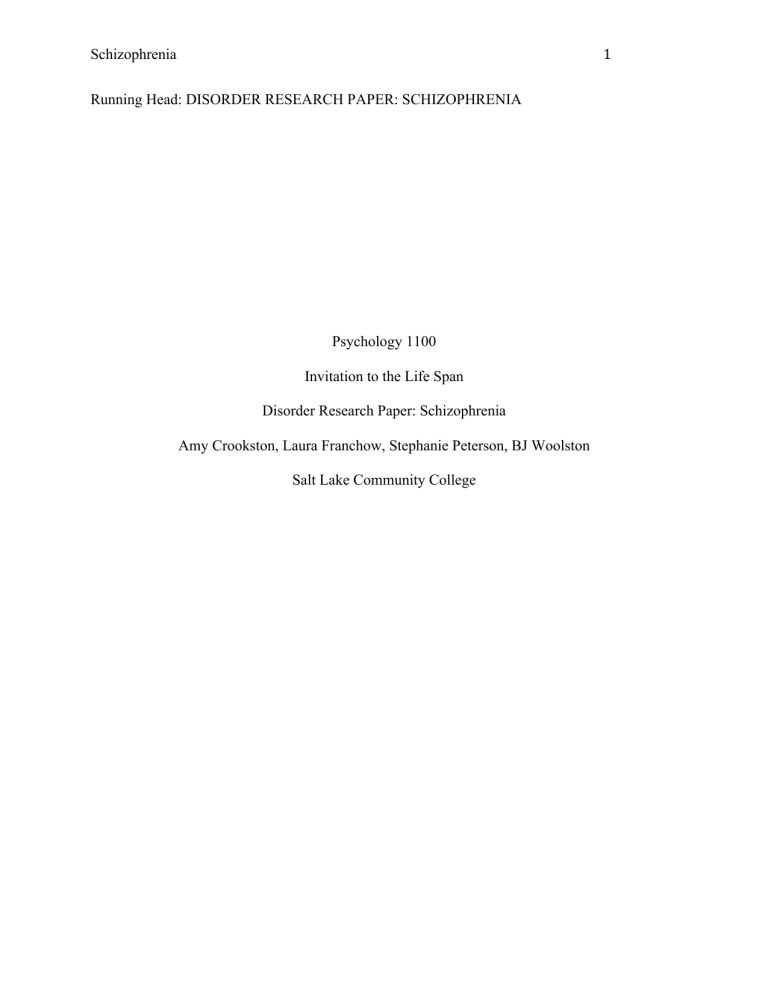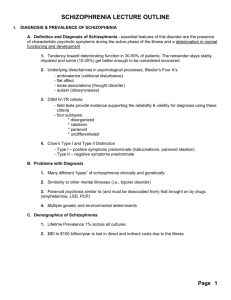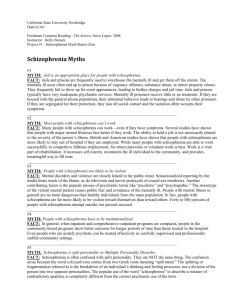Schizophrenia Research Paper

Schizophrenia
Running Head: DISORDER RESEARCH PAPER: SCHIZOPHRENIA
Psychology 1100
Invitation to the Life Span
Disorder Research Paper: Schizophrenia
Amy Crookston, Laura Franchow, Stephanie Peterson, BJ Woolston
Salt Lake Community College
1
Schizophrenia 2
Definition
Schizophrenia is a severe mental disorder characterized by some, but not necessarily all, of the following features: emotional blunting, intellectual deterioration, social isolation, disorganized speech, behavior delusions, and hallucinations. Delusions are beliefs that are not true, like people are trying to hurt them, believing other people can read their mind, or they have special abilities or powers. Hallucinations are hearing voices that are not there. People with schizophrenia may also see, smell, taste, and feel things that are not there. Disorganized speech is when the individual speaks in ways that are hard to understand or uses sentences that might not make sense. Sometimes the speech is completely incomprehensible.
Causes
Schizophrenia is quite possible the most dreaded psychological disorder there is. It is also one of the most heavily researched (Myers, 477). Unfortunately there is no concrete evidence to point toward one simple cause. However, there are several factors that have been researched, and have been proven to increase vulnerability to this disorder. Genetic predisposition, brain abnormalities, prenatal and perinatal have been discussed as an array of contributing causes.
There is no doubt that genetic predisposition enhances the probability of schizophrenia.
A child who has a biological parent that has been diagnosed with schizophrenia has approximately a one in eight chance of developing this dreaded disorder (Berger, 407). Being a twin also increases the risk, monozygotic twin’s concordance rate ranges from 30-50%, while a dizygotic twin rate decreases to about 15%. While there is a considerable drop, these rates are still considerably higher that a 1% rate which is found in the general population (McCance and
Huether, 551). While the genetic contribution is unquestionable, the genetic role is not quite so straightforward. An individual may carry the genes for schizophrenia, but not necessarily
Schizophrenia 3 manifest the illness. In 1983 behavior geneticists Susan Nicol and Irving Gottesman determined that some people:
“have the genetic predisposition to the disorder but that this predisposition by itself is not sufficient for the development of schizophrenia (Myers, 479).”
Schizophrenia may be carried, and thus a reaction to a particular situation or experiences would be the development of the disorder. As our text suggests stress may also be a contributing factor. Considering young adults who immigrated to America, those that have no family members to ease their stressful situations are three times as likely to suffer from schizophrenia
(Berger, 407).
Brain abnormalities, by way of imbalances in brain chemistry have also been labeled as a link in the causes of schizophrenia. One key to understanding schizophrenia involves the neurotransmitter dopamine. After death brain autopsies of patients’ showed a six-fold excess of dopamine receptors. At this rate dopamine could intensify brain signals, creating positive symptoms of schizophrenia (Myers, 478). One supporting factor in this theory, is that when diagnosed individuals use drugs such as amphetamines and cocaine known to increase dopamine levels, these drugs sometimes intensify schizophrenic symptoms. Such activity may be what makes victims overreact to irrelevant internal and external stimuli (Myers 478).
Another leading theory is prenatal and perinatal factors, brain development defects that occur in fetal life. Environmental influences interfere with genetically programmed brain development, which leads to variations in neural development (McCance and Huether, 551). One link that has been reported is between schizophrenia and viral infections during pregnancy.
These results come from a Finnish study of pregnant women who were exposed during their second trimester to the A2 influenza virus. Diagnosis of their offspring indicated an increase in
Schizophrenia 4 the disorder. Women who were exposed during their first and third trimesters showed their children were not affected any more than the control group (McCance and Huether, 551). This theory would support that the fetus’ were subjected to the virus, which is a teratogen during a sensitive period of development (Berger, 75). It is during the second trimester that cortical neurons are developing and swiftly migrating to take up position, orientation, and connections.
Interference of this process may lead to brain abnormalities, which have been observed in schizophrenic patients (McCance and Huether, 551).
Complications during delivery may also be associated with increased risk factors for schizophrenia. These would include a difficult delivery, prenatal and perinatal hypoxia. In studies hypoxia has been shown effective at altering brain dopamine function. Another study also reported that individuals born in winter months, peaking in February and March, were also at a higher risk. August and September were shown as the lowest risk in association with the disorder
(McCance and Huether, 552).
Early History
The beginnings of schizophrenia are hard to pinpoint in history because any person who had “mental illness, mental retardation or physical deformities were largely treated the same”
(“The History”, n.d.).
It is believed that the earliest written history of a disease with schizophrenia-like symptoms was as early as 1400 B.C in ancient Egyptian manuscripts (“The History”, n.d.;
“History of”, n.d.). Other evidence pointing to a history of mental illness such as schizophrenia is the archaeological discovery of Stone Age skulls with burr holes drilled into them in order to allow spirits to escape (Burton, 2012).
Schizophrenia 5
The earliest theories of mental illnesses were the theory that evil had possessed a body
(“The History”, n.d.). This could happen through the “possession by or involvement with the devil or other evil spirit” (“History of”, n.d.).
In the fourteenth and fifteenth centuries, it was common for people who were believed to be possessed to be burned to death. People of the day believed that mental illness was a punishment from God. By 1563, Johann Weyer wrote De praestigiis daemonum, which offered the opinion that mentally ill people were not possessed or being punished, but rather that it was a natural state. The Church did not approve of the message, forbade the book, and called Weyer a sorcerer (Burton, 2012). This effectively stopped any scientific advancement for mental illness at the time.
By the late 1700's, physicians began to treat and diagnose mental illnesses differently.
Physican Phillippe Pinel hypothesized that mental illness could be a result of being exposed to
“psychological and social stressors,” and called for a moral treatment for those who were mentally ill. During this time the first “insane institution” was opened in the British Isles
(Burton, 2012).
In the last part of the 1800's mental illnesses were starting to become differentiated by scientists and doctors. In 1871, Ewald Hecker described the symptoms of “cognitive disorganization and silliness,” a description that is still used in modern diagnosis of disorganized schizophrenia (“History of”, n.d.).
Schizophrenia was first described and identified as it's own mental illness in 1887 by Dr.
Emile Kraepelin, although it is not called schizophrenia at the time (“The History”, n.d.).
Naming of Schizophrenia
Schizophrenia 6
The first person to classify mental disorders was Dr. Emile Kraepelin. The name he gives to schizophrenic symptoms is “demetia praecox,” which literally means early dementia
(“The History, n.d.”). He names it this to distinguish it from dementia, such as Alzheimers, that he observes in his older patients, since the symptoms appear in a patient's late adolescence to mid-twenties (“History of”, n.d.). Kraepelin also described the first three types of schizophrenia: disorganized, catatonic and paranoid. Both residual and undifferentiated have been added as types of schizophrenia; however, the classifications do not “help to predict the outcome of the disorder,” and are therefore not useful in the diagnosis (“The History”, n.d.).
The term schizophrenia was used by Swiss psychiatrist Eugen Bleuler in 1911. Bleuler noted that patients with demetia praecox often did not have the symptoms of mental deterioration that were hallmarks of dementia. He also recognized that it was likely for it to occur early in life as well as later. Because of these reasons, he argued that it was not a form of dementia, and should be given its own name: schizophrenia (“The History”,n.d.). The name schizophrenia means split mind, and was used to “describe the fragmented thinking of people with the disorder” (“The History”, n.d.). Bleuler also believed that “schizophrenia led to heightened consciousness of memories and experiences” (Burton, 2012).
In 1957, Kurt Schneider created the current definition of schizophrenia (“History of”, n.d).
History of Treatment
Treatments of schizophrenia have varied over the years to correspond with people's beliefs in the cause of the disease. When people believed that mental illness was due to possession of evil spirits the treatment was to drill holes into a patient's skull (known as trephining) in order to allow the spirits inside a chance to escape (“The History”,n.d.; “History
Schizophrenia 7 of”,n.d.). If this was not successful, people were “often exorcised, flogged, starved or burned at the stake” (“History of”,n.d.).
Hippocrates hypothesized that “madness was a result of the imbalance of the four bodily humors, and that it could be cured by re-balancing the humors.” This was done through “special diet, purgatives and bloodletting” (Burton, 2012). Often bloodletting would lead to the patient's death (“History of”, n.d.).
In the middle ages when people believed mental illness was a punishment from God, the treatment often included religion, and patients were encouraged to pray and go to confession
(Burton, 2012).
In the 1800's, many schizophrenics were locked in insane asylums where the conditions were terrible and the patients were often flogged. The asylums were often used as entertainment for the general public who could pay a small fee to walk through the asylums and gawk at the patients (“History of”,n.d.).
By the early 1900's fever therapy was a common treatment for schizophrenia. Doctors would inject their patients with foreign substances in an effort to raise the body temperature and kill the mental illness as well. Other treatments included “sleep therapy, gas therapy, electroconvulsive or electroshock treatment and prefrontal leucotomy.” All of these treatments were used to control the behavior of the patient rather than to cure or alleviate suffering of the patient (Burton, 2012).
In the 1900's Freud influenced the thinking that schizophrenia was a “result from unconscious conflicts that originated in childhood” (Burton, 2012).
In the 1950's the first medication Thorazine was used to successfully treat the symptoms of schizophrenia. Since then, many more medications have come on the market, and allow
Schizophrenia 8 sufferers of schizophrenia to live more normal lives when taking their medication (“History of”,n.d.).
Recent History
Over the past few decades, diagnosis and treatment of schizophrenia have advanced significantly. Through “advanced brain imaging and molecular genetic studies” we have been able to confirm schizophrenia as a biological disease of the brain ( “The History”,n.d.; Burton,
2012). However, it is also understood that there is a psychological basis and that social stresses play a part in triggering episodes of the illness (Burton, 2012).
Treatment
Currently the most common and effective form of treatment for schizophrenia is with antipsychotic medications. Some more severe situations may require a hospital stay throughout the length of the episode for the safety of themselves and others. Schizophrenia is a lifetime disease and will require a lifetime of treatment and medication. Along with medications support groups and teaching skills can help.
Resources suggest that medications have been the most effective treatment tool. The antipsychotic medications change how chemicals are balanced in the brain and help control some symptoms. More common side effects from medications include dizziness, restlessness, feeling tired, slow movements, tremors, and weight gain. Some side effects can be managed and specialists suggest that patients not let side effects sway them from treatment. One long-term concern with antipsychotic meds is a movement disorder called tardive dyskinesia. This causes movements that can not be controlled and commonly affects the mouth. Clozapine is used if other medications are not successful. This has been the most effective medication for schizophrenia; however, it also has the strongest onset of side effects.
Schizophrenia 9
Supportive care and skills instruction are also helpful. Helping patients to gain skills in social settings and a work atmosphere can help establish positive habits and establish healthier norms. Along with the patient attending relationship classes, it’s important for familiy members to also be a part of treatment. Not only can they be a strong support system, but they can also learn about the condition and its functions. There are some community programs available to those without family. Some of the main goals of these programs would include proper administration of medication(s), recognizing warning signs of relapse, skills to cope with symptoms, and life skills such as finance, hygiene, transportation, etc. Prognosis is difficult and predicting the outcome of treatment for schizophrenia is difficult. Medication, typically, improves symptoms substantially.
Schizophrenia 10
References
Berger, K.S. (2010). Invitation to the lifespan (sixth edition). New York: Worth Publishers.
McCance, K.L., Huether, S.E. (2002). Pathophysiology: The biologic basis for disease in adults
& children (fourth edition). St. Louis: Mosby.
Myers, D.G. (1998). Psychology (fifth edition). New York: Worth Publishers.
Freudenreich O, Weiss AP, Goff DC. Psychosis and schizophrenia. In: Stern TA, Rosenbaum JF,
Fava M, Biederman J, Rauch SL, eds. Massachusetts General Hospital Comprehensive
Clinical Psychiatry . Retrieved from http://www.ncbi.nlm.nih.gov/pubmedhealth/PMH0001925/
Burton, N. (2012, September 8). A Brief History of Schizophrenia | Psychology Today.
Psychology Today: Health, Help, Happiness + Find a Therapist . Retrieved March 6,
2013, from http://www.psychologytoday.com/blog/hide-and-seek/201209/brief-historyschizophrenia
History of Schizophrenia. (n.d.). Schizophrenic . Retrieved March 6, 2013, from http://www.schizophrenic.com/content/schizophrenia/history-schizophrenia
The History of Schizophrenia. (n.d.). Schizophrenia.com, Indepth Schizophrenia Information and
Support . Retrieved March 6, 2013, from http://www.schizophrenia.com/history.htm







